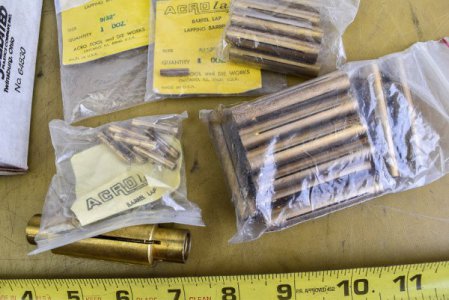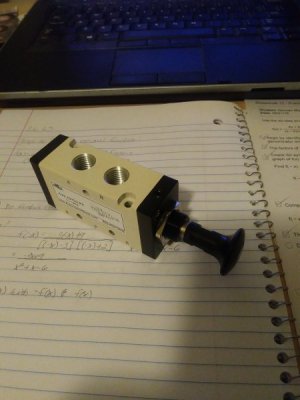-
Welcome back Guest! Did you know you can mentor other members here at H-M? If not, please check out our Relaunch of Hobby Machinist Mentoring Program!
- Forums
- THE MAIN DISCUSSION SECTION
- TOOL JUNKIES - Love Tools? This is your forum!
- What Did You Buy Today? Tool Junkie Archives
You are using an out of date browser. It may not display this or other websites correctly.
You should upgrade or use an alternative browser.
You should upgrade or use an alternative browser.
2018 Archive
- Thread starter GoceKU
- Start date
- Status
- Not open for further replies.
- Joined
- Nov 23, 2014
- Messages
- 2,606
Month or so of pick ups off eBay and internet orders. Didn't picture it, but also bought a couple of gallons of Trim-sol coolant for the mill's mister.
Bruce
More ball end Allen wrenches in English and Metric
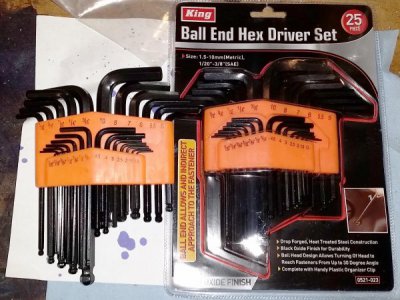
Starrett metric screw pitch gauge
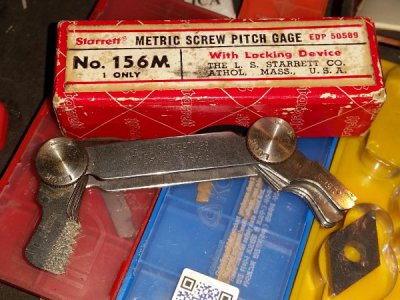
Roper Whitney model XX hand punch
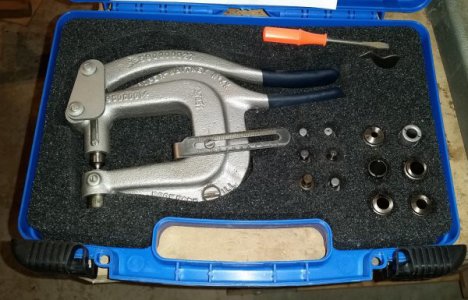
Punches/dies for gaskets and washers. This set comes with pins that can
load onto the punches for making washers.
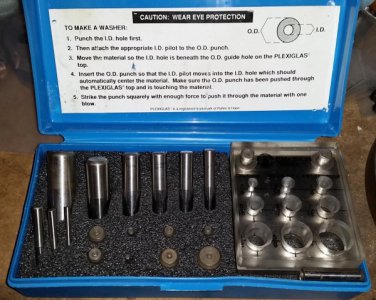
Bag of Scotch-brite pads
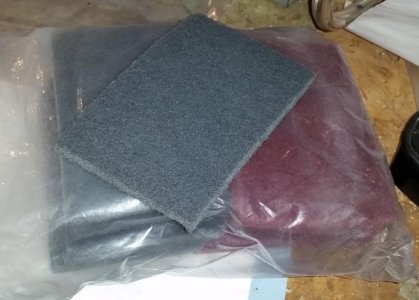
Nice set of American made HSS drill bits: 1/16" - 1/2" by 1/64", 1-60, A-Z
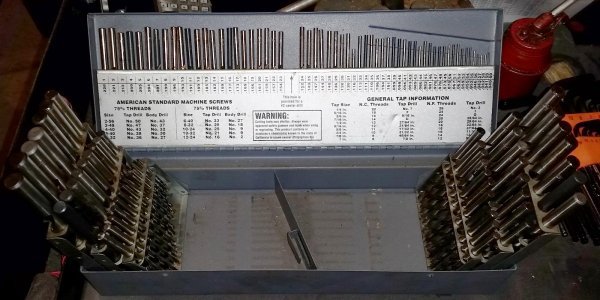
Set of 1/32" thick parallels from Shars
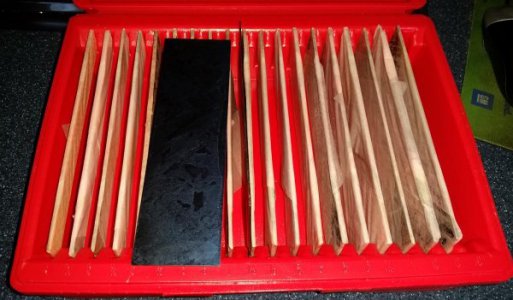
Freshly sharpened solid carbide drills off eBay
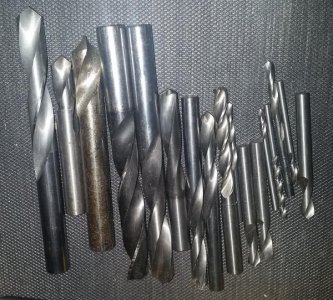
6" x 12" steel shim stock from 0.001" - 0.015"
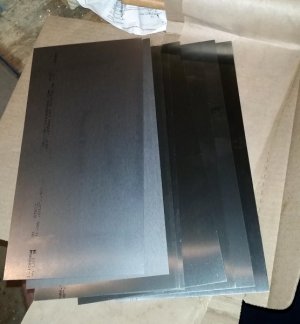
Honing sticks
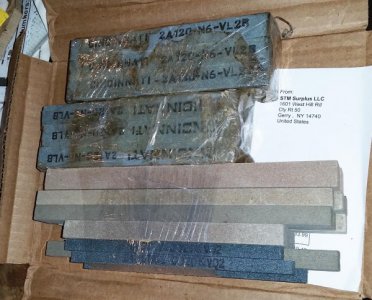
Yet more slitting saws
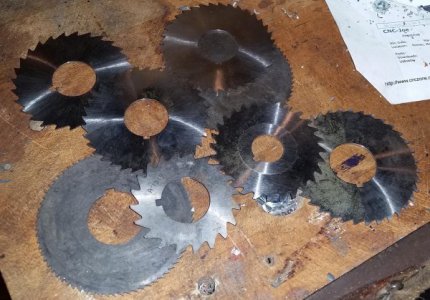
Set of Metric HSS drill bits
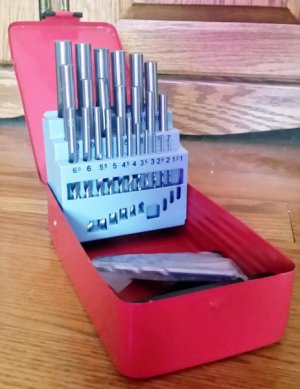
Nice box of Scotch-brite buffing wheels
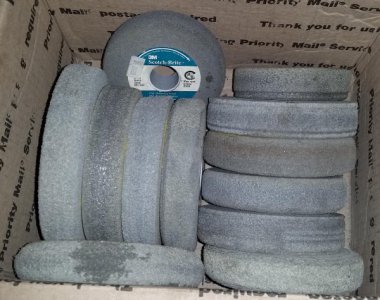
Bruce
More ball end Allen wrenches in English and Metric

Starrett metric screw pitch gauge

Roper Whitney model XX hand punch

Punches/dies for gaskets and washers. This set comes with pins that can
load onto the punches for making washers.

Bag of Scotch-brite pads

Nice set of American made HSS drill bits: 1/16" - 1/2" by 1/64", 1-60, A-Z

Set of 1/32" thick parallels from Shars

Freshly sharpened solid carbide drills off eBay

6" x 12" steel shim stock from 0.001" - 0.015"

Honing sticks

Yet more slitting saws

Set of Metric HSS drill bits

Nice box of Scotch-brite buffing wheels

- Joined
- Nov 23, 2014
- Messages
- 2,606
Bought another SDA laser center/edge finder. They sell three basic models that project either a dot, a cross hair or concentric circles with a center dot. They are advertised as a replacement for mechanical and electronic edge finders. I picked up the cross hair model last fall and recently took the plunge on the concentric circle model.
In summary, do you need to get one or both? Quick answer is NO. "Your results may vary", but they won't be my "go to" edge finders. Use will be determined by the accuracy needed on the project. That being said, I will use them, but not as often as I should to justify the cost.
I'm able to hit about 0.004" repeatably finding center with the cross hair model. Set a Dykem'd center punched piece on the mill and found center. Zero'd the DRO, moved off the part and repeated 6 times. It does work well for quickly finding a scribed point on a part. Quicker than a wiggler or my Blake co-ax with the spring loaded center finder. If the project requires spot-on locating, I'll go with the Blake. Accuracy not as important, I'll pull out the laser cross hair.
On to the concentric circle model. I checked my repeatability on finding a pricked hole by finding what I thought was the center and zero'd the DRO. Then moved off the part and repeated finding center. Was able to hit within 0.003" of center each time on 6 trials. So not too bad, and it does go quicker than a wiggler or using the Blake. Down side is turning off the shop lights so the laser dot can be dialed down to as small as possible to get an accurate position. Naturally, the smaller the dot, the less light you see, but it gives a better shot of getting spot-on to the pricked hole.
It's recommended to check the laser's centering with each use to a supplied target cross hair. The lasers have 4 set screws around the base for centering the dot/circles much like a 4-jaw chuck. I centered up the laser by turning the spindle 90 degrees and adjusted the set screws so the edge of the largest circle was on the same point. Could do the same thing with the center dot, but figured the most accurate way of centering would be to adjust the unit at the furthest point from center.
I tested the concentric rings by bolting a dividing head plate to the mill table and ran the table up/down until one of the projected circles was right at the outside of the disk. Zero'd out the table and mounted a DTI holder on the spindle and swept the outside of the disk. Ended up repeatably hitting about 0.007" from center. Again, not too bad depending on the accuracy needed. It is quicker than using a DTI or the Blake.
OK, not a recommended process but something I do to avoid centering the laser with each use. I run the mill at low speed with laser on and eyeball the dot/circle to centered on the pricked hole. I get within 0.005" doing this. On the plus side, running the spindle takes out spindle run-out for centering. On the down side, it effectively makes the laser dot larger so I'm basically eyeballing to center an 0.010" dot on a pricked hole instead of an 0.005" dot on a pricked hole. Again, depends on the accuracy you need.
Bruce
Picked up a concentric circle laser edge finder. The cross-hair and circle units
have the same base, but use different lens.
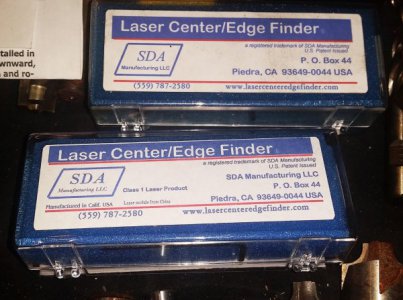
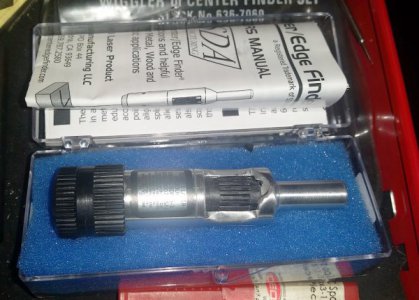
Circles projected onto a dividing head disk. Circle sizes are varied by
moving the table and/or spindle up/down. The polarizing filter can be adjusted
to shrink the size of the circles, but there's less light to see so off go the shop
lights.
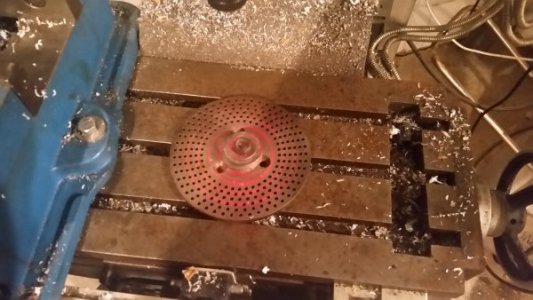
Did a check with a TDI after finding center with the laser circles. Was able to hit
0.007" or better with the laser.
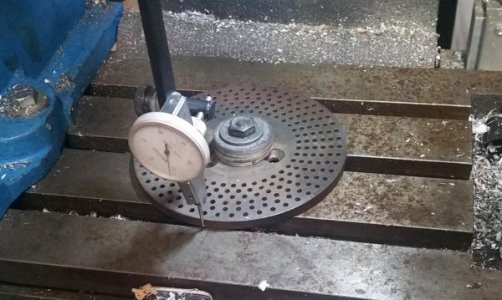
In summary, do you need to get one or both? Quick answer is NO. "Your results may vary", but they won't be my "go to" edge finders. Use will be determined by the accuracy needed on the project. That being said, I will use them, but not as often as I should to justify the cost.
I'm able to hit about 0.004" repeatably finding center with the cross hair model. Set a Dykem'd center punched piece on the mill and found center. Zero'd the DRO, moved off the part and repeated 6 times. It does work well for quickly finding a scribed point on a part. Quicker than a wiggler or my Blake co-ax with the spring loaded center finder. If the project requires spot-on locating, I'll go with the Blake. Accuracy not as important, I'll pull out the laser cross hair.
On to the concentric circle model. I checked my repeatability on finding a pricked hole by finding what I thought was the center and zero'd the DRO. Then moved off the part and repeated finding center. Was able to hit within 0.003" of center each time on 6 trials. So not too bad, and it does go quicker than a wiggler or using the Blake. Down side is turning off the shop lights so the laser dot can be dialed down to as small as possible to get an accurate position. Naturally, the smaller the dot, the less light you see, but it gives a better shot of getting spot-on to the pricked hole.
It's recommended to check the laser's centering with each use to a supplied target cross hair. The lasers have 4 set screws around the base for centering the dot/circles much like a 4-jaw chuck. I centered up the laser by turning the spindle 90 degrees and adjusted the set screws so the edge of the largest circle was on the same point. Could do the same thing with the center dot, but figured the most accurate way of centering would be to adjust the unit at the furthest point from center.
I tested the concentric rings by bolting a dividing head plate to the mill table and ran the table up/down until one of the projected circles was right at the outside of the disk. Zero'd out the table and mounted a DTI holder on the spindle and swept the outside of the disk. Ended up repeatably hitting about 0.007" from center. Again, not too bad depending on the accuracy needed. It is quicker than using a DTI or the Blake.
OK, not a recommended process but something I do to avoid centering the laser with each use. I run the mill at low speed with laser on and eyeball the dot/circle to centered on the pricked hole. I get within 0.005" doing this. On the plus side, running the spindle takes out spindle run-out for centering. On the down side, it effectively makes the laser dot larger so I'm basically eyeballing to center an 0.010" dot on a pricked hole instead of an 0.005" dot on a pricked hole. Again, depends on the accuracy you need.
Bruce
Picked up a concentric circle laser edge finder. The cross-hair and circle units
have the same base, but use different lens.


Circles projected onto a dividing head disk. Circle sizes are varied by
moving the table and/or spindle up/down. The polarizing filter can be adjusted
to shrink the size of the circles, but there's less light to see so off go the shop
lights.

Did a check with a TDI after finding center with the laser circles. Was able to hit
0.007" or better with the laser.

- Joined
- Feb 17, 2013
- Messages
- 4,406
Question, Bruce -
Did you try rotating the spindle ½ turn and repeat the tests, to check for runout? Having read a bunch of your posts, I'm confident that your spindle is OK ... but what about the laser unit?
I've read (and seen on a Youtube video - either Joe PI or Don Bailey) that reasonable amounts of runout will NOT affect the accuracy of the traditional edge finder.
Did you try rotating the spindle ½ turn and repeat the tests, to check for runout? Having read a bunch of your posts, I'm confident that your spindle is OK ... but what about the laser unit?
I've read (and seen on a Youtube video - either Joe PI or Don Bailey) that reasonable amounts of runout will NOT affect the accuracy of the traditional edge finder.
- Joined
- Nov 23, 2017
- Messages
- 1,191
I got bought a whole drawer full of Starrett pin punches and center punches..




A few small cheap squares

A bunch of shim stock



And a 2 1/4" - 8 Tap





A few small cheap squares

A bunch of shim stock



And a 2 1/4" - 8 Tap

Last edited:
- Joined
- Nov 23, 2014
- Messages
- 2,606
Hi John,Question, Bruce -
Did you try rotating the spindle ½ turn and repeat the tests, to check for runout? Having read a bunch of your posts, I'm confident that your spindle is OK ... but what about the laser unit?
I've read (and seen on a Youtube video - either Joe PI or Don Bailey) that reasonable amounts of runout will NOT affect the accuracy of the traditional edge finder.
I checked the 3/8" collet with a dowel pin before dropping in the laser (0.0004" run out). I will say that they are fast. The circles are pretty thick (about 0.015"), so wouldn't rely on them for anything that needs to be dead on. I thought about using it for setting up a rotary table, but will stick with the tapered pin I currently use.
Best regards, Bruce
- Joined
- Nov 23, 2014
- Messages
- 2,606
Hi John,Question, Bruce -
Did you try rotating the spindle ½ turn and repeat the tests, to check for runout? Having read a bunch of your posts, I'm confident that your spindle is OK ... but what about the laser unit?
I've read (and seen on a Youtube video - either Joe PI or Don Bailey) that reasonable amounts of runout will NOT affect the accuracy of the traditional edge finder.
I checked the 3/8" collet with a dowel pin before dropping in the laser (0.0004" run out). I will say that they are fast. The circles are pretty thick (about 0.015"), so wouldn't rely on them for anything that needs to be dead on. I thought about using it for setting up a rotary table, but will stick with the tapered pin I currently use.
Best regards, Bruce
- Joined
- Nov 23, 2017
- Messages
- 1,191
- Status
- Not open for further replies.




